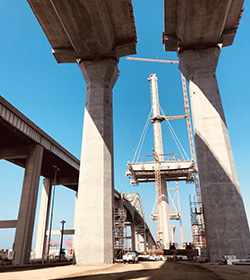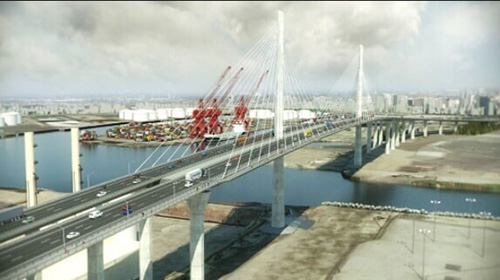Gerald Desmond Bridge Replacement
Long Beach, California
Client:
The Port of Long Beach, California
Cheng C. Lai, SE
Email:
lai@polb.com
Caltrans
Emil A. Vergara, PE
Email:
emil_vergara@dot.ca.gov
ARUP
Kevin Acosta
Email:
kevin.acosta@arup.com
Date:
Scheduled construction completion 2019
Independent check completed 2016
Scope of work:
Independent Check of the Cable-Stayed Bridge
Construction cost:
US $1.2 Billion
Services Performed:
- Nonlinear time history analysis and of the cable-stayed bridge
- Independent design check of the cable-stayed bridge
- Review of concrete segmental approach spans erected by movable scaffolding systems
Issues:
- Complex seismic analysis and design
- Use of dampers
- Design for high seismic zone
- Complex construction method
 The existing through arch bridge was built in 1968 and carries four lanes of Ocean Boulevard from Interstate 710 in Long Beach, California, west across the Back Channel to Terminal Island. In 2010, the Port of Long Beach decided to replace the existing bridge due to its deficiencies.
The existing through arch bridge was built in 1968 and carries four lanes of Ocean Boulevard from Interstate 710 in Long Beach, California, west across the Back Channel to Terminal Island. In 2010, the Port of Long Beach decided to replace the existing bridge due to its deficiencies.
The replacement bridge will carry a six-lane roadway with emergency lanes on each side, and will also carry a pedestrian/bike path and observation decks over the water along the south side of the bridge. From west to east, the new bridge is consisting of a 2,800 ft. long West Approach, a 2,000 ft. long cable-stayed span and a 3,600 ft. long East Approach .
The new bridge will be built north of the existing bridge and will allow access to the port for the tallest container ships, and will be the first long-span cable-stayed bridge in California. A design-build contract was awarded to the SFI JV (A joint venture of Shimmick Construction Company Inc., FCC Construction S.A. and Impregilo S.A.) in July 2012. The lead designer for the SFI JV is Arup North America.
OPAC is engaged by ARUP to perform an independent design check of the cable-stayed spans, with lengths of 500 ft., 1000 ft. and 500 ft. Services include independent global seismic analysis of the entire bridge by Adina and independent design check of cable-stayed bridge structural components. OPAC also performed time dependent step-by-step construction analysis of the entire bridge with SFRAME/S3D to evaluate the erection method proposed by the designer.
In addition, Kwong Cheng of OPAC served as Lead Designer for the Approaches through the 35% design phase. Services include technical support and review of approach structure design which consists of mostly prestressed concrete box girders to be erected by span-by-span method using movable scaffolding systems (MSS).

